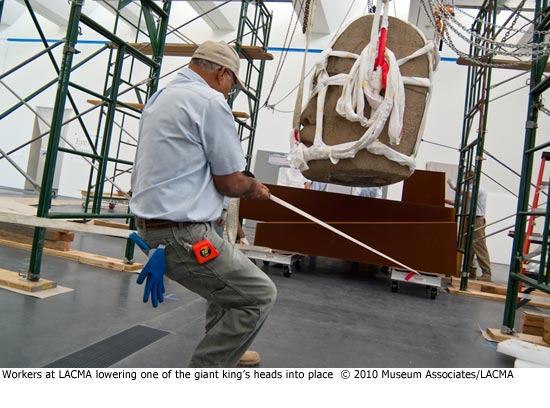A head of their time
September 21, 2010
Before L.A.’s cultural bigshots can walk down the red carpet for the gala opening of LACMA’s new Resnick Pavilion, some real heavyweights had to make their own grand entrances.
The big men are a pair of Mexican kings, giant basalt heads of long-dead rulers of an ancient Mexican civilization that flourished more than 3,000 years ago.
They are the stars of “Olmec: Colossal Masterworks of Ancient Mexico,” one of three inaugural exhibitions that will launch the new Lynda and Stewart Resnick Exhibition Pavilion at LACMA, which opens to the public on October 2 after festivities that include a grand gala opening.
Grand ceremony wouldn’t faze the two Olmec kings, whose names are lost to history but whose unforgettable heads weigh between 4 and 5 tons. The larger of the two depicts a ruler with a stern and masterful face. The other wears a sly half smile.
“These are individuals, and they are meant to be massive portraits,” said Virginia Fields, a co-curator of the show and LACMA’s senior curator of the arts of the Ancient Americas. The pair came from the ancient Olmec city of San Lorenzo Tenochtitlan, near modern Veracruz.
The kings’ elaborate royal progress from Mexico to LACMA was fit for a monarch. Wrapped in cloth and packed in padded wooden crates, the heads were air freighted north. Upon arrival at the Resnick Pavilion, they were met by work crews who gently unpacked them and strapped them to gantries and pulleys.
“I kept thinking, ‘How would the Olmecs have done this?’” Fields thought as she watched work crews carefully steering the giant heads to their resting places.
Then they were gently lowered onto a pair of monumental oxidized steel platforms designed by American sculptor Michael Heizer. Heizer, coincidentally, learned about the Olmecs as a boy. (His father was a UC Berkeley archeologist who studied Olmec culture.)
Joining the kings are about 120 other works large and small, including bowls, axes, pottery and sculpture. Among the large pieces: a pair of seated “twins,” who were priests or rulers, dressed alike in elaborate turbans. A large and mysterious woman standing at the mouth of a cave is the only large female figure ever found in Olmec art, said Fields.
In addition to the Olmec exhibit, two other shows will launch the Resnick, a striking gallery by Italian architect Renzo Piano, who also designed the neighboring Broad Contemporary Art Museum at LACMA.
“Eye for the Sensual: Selections from the Resnick Collection” showcases highlights of the family’s collection of European and American paintings, sculpture and decorative arts from the 16th to 20th century, including Art Deco masterpieces and an iconic portrait of Queen Marie-Antoinette.
“Fashioning Fashion: European Dress in Detail, 1700-1915,” is a kaleidoscopic display of the evolution of fashion styles and techniques featuring 250 gowns, dresses and suits.
The world premiere of all three exhibits—and of the building itself—comes Saturday night, September 25, with an invitation-only fundraising gala featuring a performance by Christina Aguilera. The dinner will honor the Resnicks, L.A. area business owners and philanthropists who gave $45 million to build the museum.
On the 28th, the museum hosts community partners for another preview.
The building will be thrown open to the general public with a free community weekend October 2-3 that will feature Latin music and storytelling as well as admission to the entire museum. The free entry does require tickets, which can be reserved now by calling (323) 857-6010 or visiting LACMA’s website.
Posted 9/21/10




















 405 bridge work causes a stink
405 bridge work causes a stink